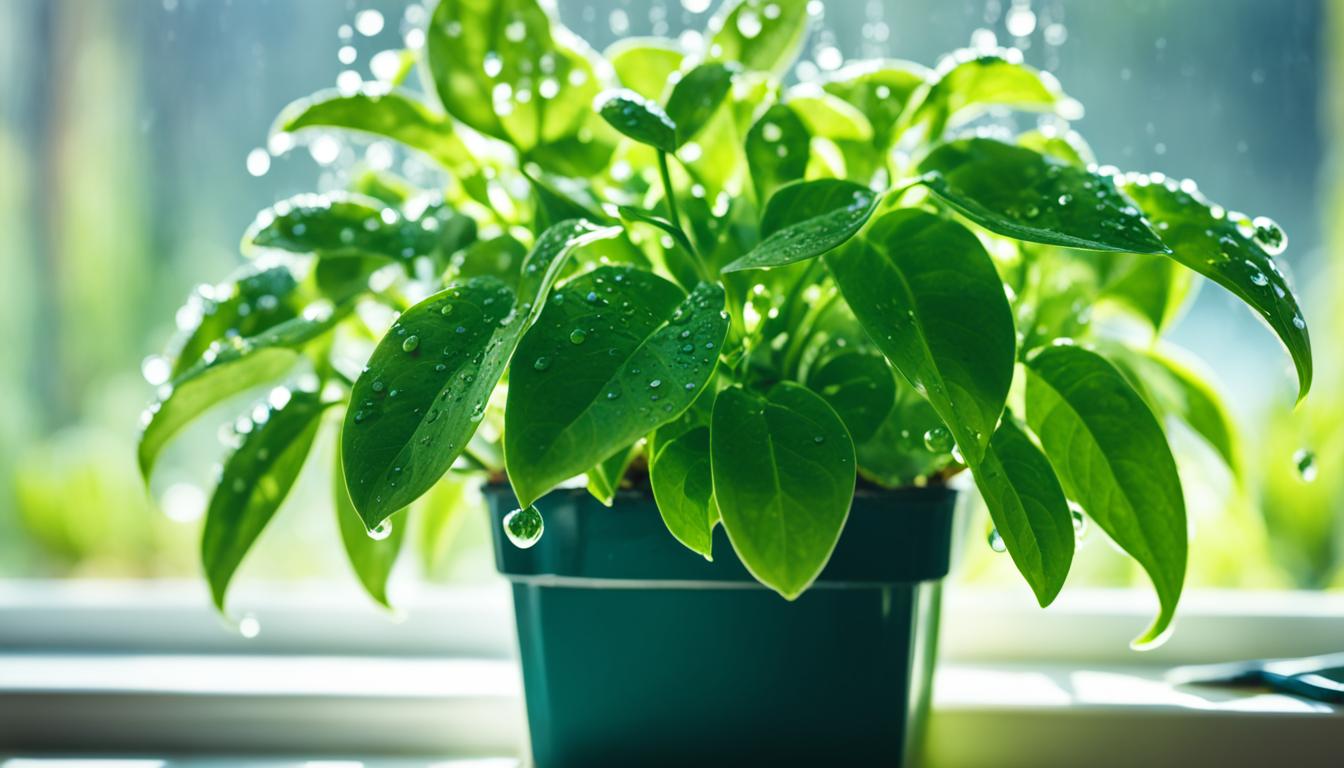
Embarking on the journey of nurturing houseplants requires a comprehensive plant care guide that caters to the unique needs of your green companions. Proper indoor plant care begins with understanding the vital role of light in stimulating the flourishing of various plant species. This entails placing your greenery near a south-facing window to bathe them in the bright light they crave, while also considering the use of sheer curtains to temper the sun’s intensity and prevent potential harm.
Moreover, the selection of plants should resonate with your lifestyle, ensuring that your living space and daily routine harmonize with the plant care basics they demand. Whether you’re often out on adventures or homebound, there’s a plant that will thrive under your care. From the unfussy requirements of succulents to the nurturing embrace given to humidity-loving ferns, the right plant care instructions will ensure your flora not only survives but thrives. Let’s delve deeper into shaping a sanctuary where your plants can reach their optimum potential.
Mastering Light & Temperature for Thriving Houseplants
The cornerstone of excellent houseplant care involves creating an environment that mimics the natural conditions your plants would experience in the wild. To ensure you’re caring for plants successfully, special attention needs to be given to two critical factors: light and temperature.
- Understand the light preferences of your plants: Some species will thrive in full sunlight, while others need shaded or indirect light to prosper. Tailor your plant placement in your home accordingly.
- Regulate temperature for optimal growth: Keep the ambient temperature within the ideal range of 65 to 85 degrees F. It’s vital to protect your plants from temperature shocks such as those from drafty windows or heating systems.
Adopt these practices for plant maintenance, and observe how your houseplants not only survive but genuinely thrive in their indoor habitat:
- Align your plant’s environment to its native habitat—use humidifiers for tropical plants and positioning strategies for others that prefer arid climates.
- Prevent exposure to sudden temperature changes by situating plants away from appliances that emit heat or cold drafts.
- Consider the creation of plant groupings to generate mini microclimates, which can be especially beneficial during seasonal changes.


Executing these plant care strategies will significantly improve the health and vitality of your indoor garden. By mastering the nuances of light exposure and maintaining stable temperature conditions, your houseplants can become a lush and thriving aspect of your home.
Water Wisely: Navigating Plant Hydration Needs
Adopting the right approach to watering is critical for maintaining the health of your houseplants. Plant care tips often stress the ‘less is more’ philosophy to prevent common issues like root rot and ensure your green companions are hydrated just right. Let us delve into the methods and considerations necessary for watering plants appropriately and mastering houseplant hydration.


Understanding the Soak and Dry Method
One of the top plant care tips for effective houseplant hydration is mastering the Soak and Dry method. Rather than adhering to a strict watering timetable, assess the moisture level of the soil by probing two inches below the surface. If the soil feels dry, it’s time to water generously, allowing excess water to drain. This technique ensures that the roots absorb enough moisture without becoming waterlogged.
The Balance of Moisture for Different Plant Types
- Identify the moisture preferences of your plants, as each species has unique needs.
- Cacti and succulents thrive with less frequent waterings, storing water within their fleshy tissues.
- Tropical plants, in contrast, often require consistently moist soil that mimics their natural rainforest habitat.
- Reactive watering, where you respond to the plant’s signs of thirst, may be preferable to prevent over-hydration.
Seasonal Watering Adjustments
- During the active growing season, typically spring and summer, plants may need more frequent watering.
- In the winter months, reduce watering as plant growth slows and evaporation rates decrease.
- Adjust your watering schedule based on the environmental conditions; heated interiors in winter can dry out soil quicker.
Remember, appropriate watering is just as much about the timing as it is about the quantity. With these plant care tips, you’ll be on your way to providing the right amount of houseplant hydration for thriving greenery.
Feeding Your Foliage: Essential Nutrients for Plant Vitality
Understanding the specific needs of houseplants when it comes to plant nutrition is crucial for their growth and vitality. Unlike outdoor plants, indoor varieties require a more tailored approach to fertilization, one that accommodates their lower exposure to the natural elements. This involves implementing fertilizing practices that balance providing essential nutrients without the risk of overwhelming the plant.


Diligently applying fertilizers during a plant’s active growth period is key to plant growth enhancement. Usually demarcated between early spring and fall, this period indicates an optimal time for plants to receive extra nutrition to support their growing needs. However, it’s important to adopt a conservative approach to avoid over-fertilizing, which can be equally detrimental to plant health.
- Employ a diluted all-purpose fertilizer to meet the general needs of your indoor plants.
- Adhere to the philosophy of ‘less is more’ to prevent fertilizer burn and root damage.
- Avoid fertilizing new plants or those in fresh soil, allowing them to utilize the existing nutrients.
- Opt for fertilizers with balanced N-P-K (nitrogen, phosphorus, potassium) values to nurture flowering plants without inhibiting blossoming.
Incorporating these guidelines into your plant care routine will help maintain a healthy balance of nutrients, fostering a home environment where your foliage can thrive. By doing so, you cultivate not only the beauty of your plants but also their contributions to a refreshing and vibrant living space.
The Roots of Health: Repotting Practices for Healthy Plants
Successful repotting houseplants is a nuanced art that serves as a cornerstone for maintaining exceptional root health and leveraging advanced planting techniques. As greenery enthusiasts, it’s vital to acknowledge that this process is more than just upgrading to a new container; it’s an integral ritual for revitalizing our cherished leafy companions. One must vigilantly monitor a plant’s development and recognize the telltale signs that beckon for a repotting session, such as roots peeping out of drainage holes or a visible slowing in growth.
When transitioning a plant to a new abode, it is imperative to choose a pot that comfortably accommodates growth without offering too much space, as an over-sized pot could lead to waterlogging and potential root decay. A container 1-3 inches larger in diameter strikes the perfect balance, enabling the plant to stretch its roots without the risk of overwatering that looms with excess soil.
- Examine the root structure carefully for signs of encircling, which hints at space constraints in the current pot.
- Gently free the roots to encourage them to spread outward and trim only if necessary, using sterilized pruning tools to prevent disease transmission.
- Opt for a high-quality potting mix that caters to your specific plant’s needs, as this new soil will be a primary source of nutrients for the upcoming growth period.
Sensitive to the transitional phase, a plant may exhibit signs of stress post-repoting. It’s a time where your attentive care can guide them back to their vigorous selves. Keep a close eye on watering habits post-transition and protect them from harsh conditions while they settle into their new environment.
Employing the right repotting tactics not only secures the future vitality of your plant but also ushers in a rejuvenated phase of luscious growth, making it a rewarding endeavor for any plant parent committed to nurturing their green oasis. Remember, the longevity and prosperity of your houseplants are deeply rooted in the attentiveness and proficiency you apply during these pivotal moments.


Ultimate Plant Care Guide: Maintenance for Peak Plant Health
A thriving indoor garden is the culmination of diligent plant maintenance and a well-structured indoor plant care routine. Neglect can lead to a host of problems, ranging from dust accumulation to disease. Integrating a holistic approach to plant care will ensure your green companions not only survive but flourish. Below, we delve into fundamental practices that are key to nurturing plant health and vibrancy.
Cleaning and Dusting Your Plants
Regular cleaning is a cornerstone of plant maintenance. Leaves caked with dust can’t soak up sunlight efficiently, which is essential for photosynthesis. To preserve plant health, use a soft brush to gently remove debris or give your plants a lukewarm shower. This straightforward task can have a profound impact on your plant’s ability to breathe and absorb essential nutrients.
Pest and Disease Prevention Strategies
Vigilance is crucial in disease prevention in plants. Inspect your plants regularly for signs of infestation or sickness – discoloration, spots, or a sticky residue on the leaves can all be indicators. Implementing preventative measures such as quarantine for new plants and avoiding overwatering can intercept problems before they take hold, safeguarding your foliage from harm.
Pruning Techniques for Growth and Aesthetics
Pruning is much more than a mere cosmetic routine; it’s a vital aspect of an indoor plant care routine that promotes plant health. Strategic trimming can stimulate growth, improve air circulation, and yield a robust plant structure. Removing dead or diseased foliage helps in preventing the spread of infections and enhances the overall appearance of your plant. Whether it’s maintaining a shape or encouraging new growth, pruning for plant health is an essential element of plant care.






